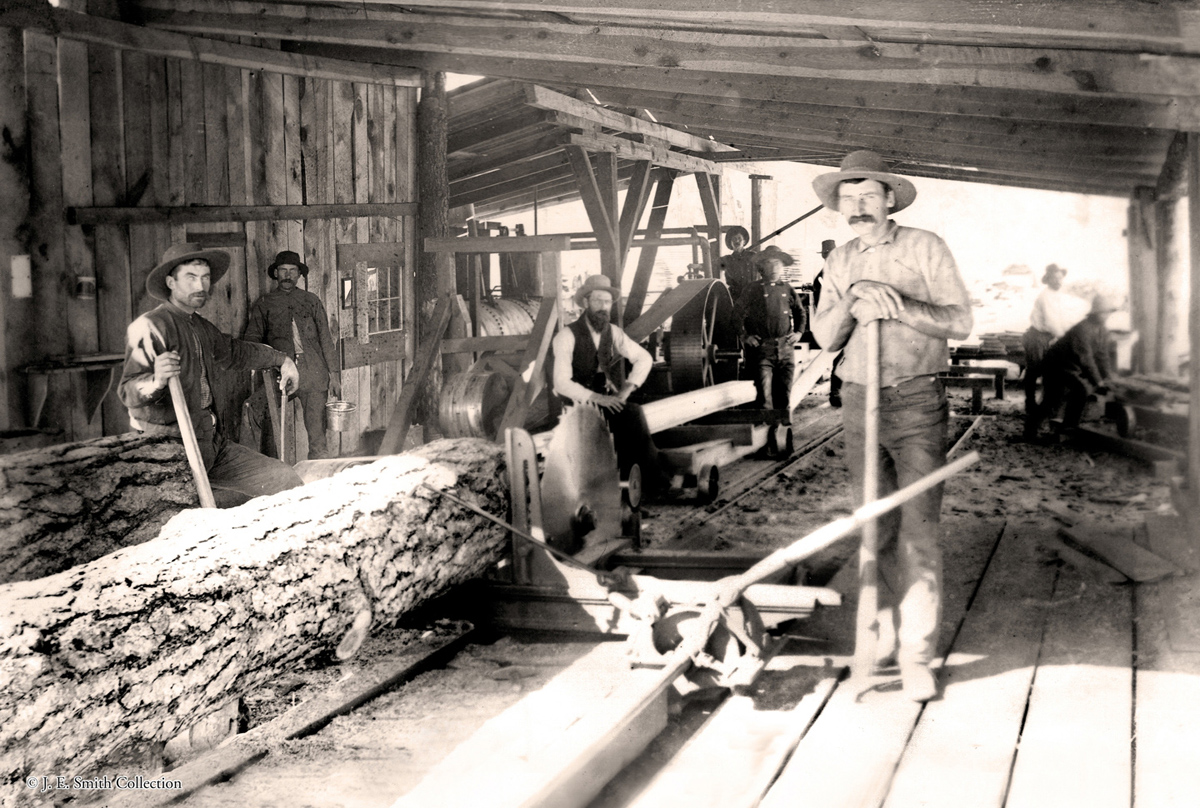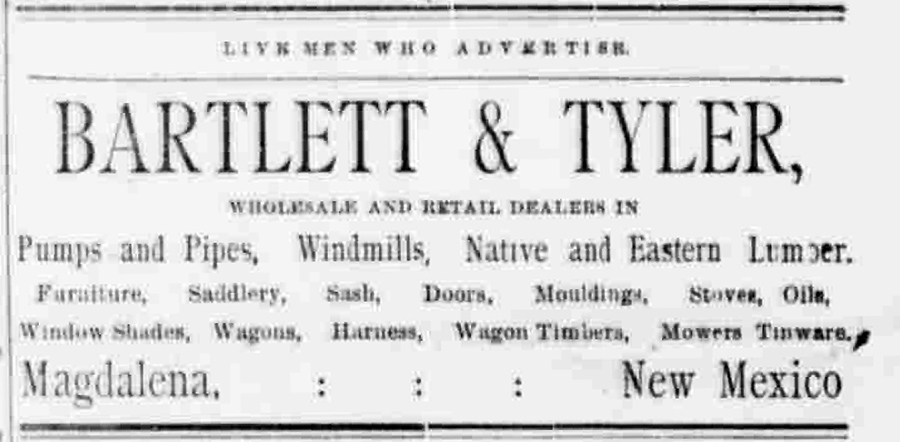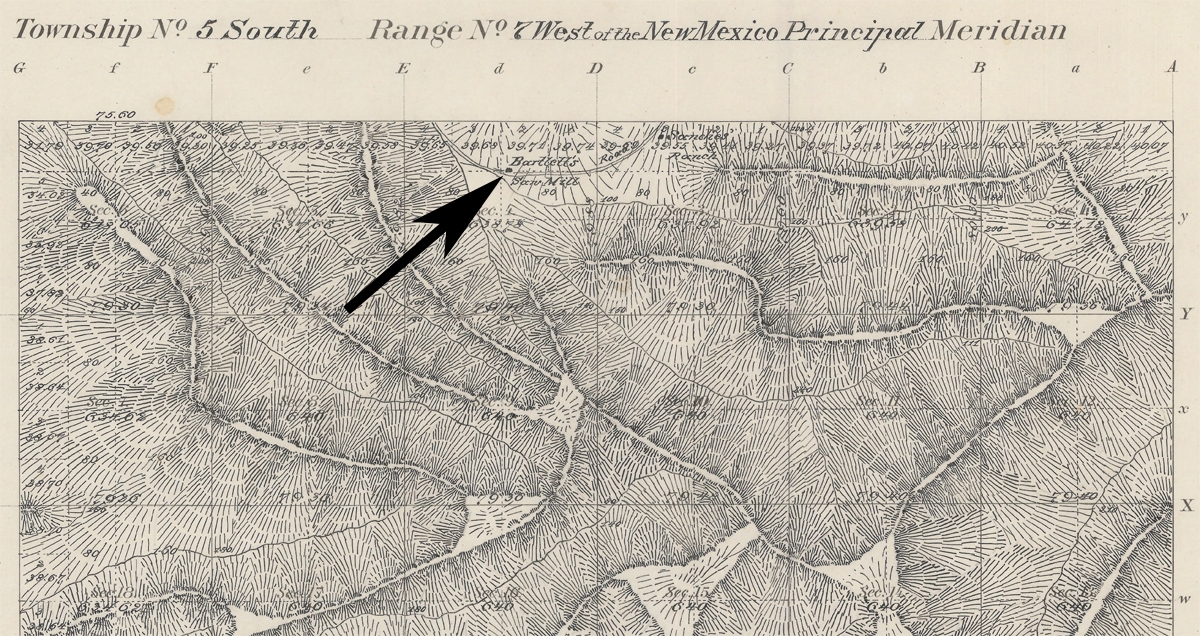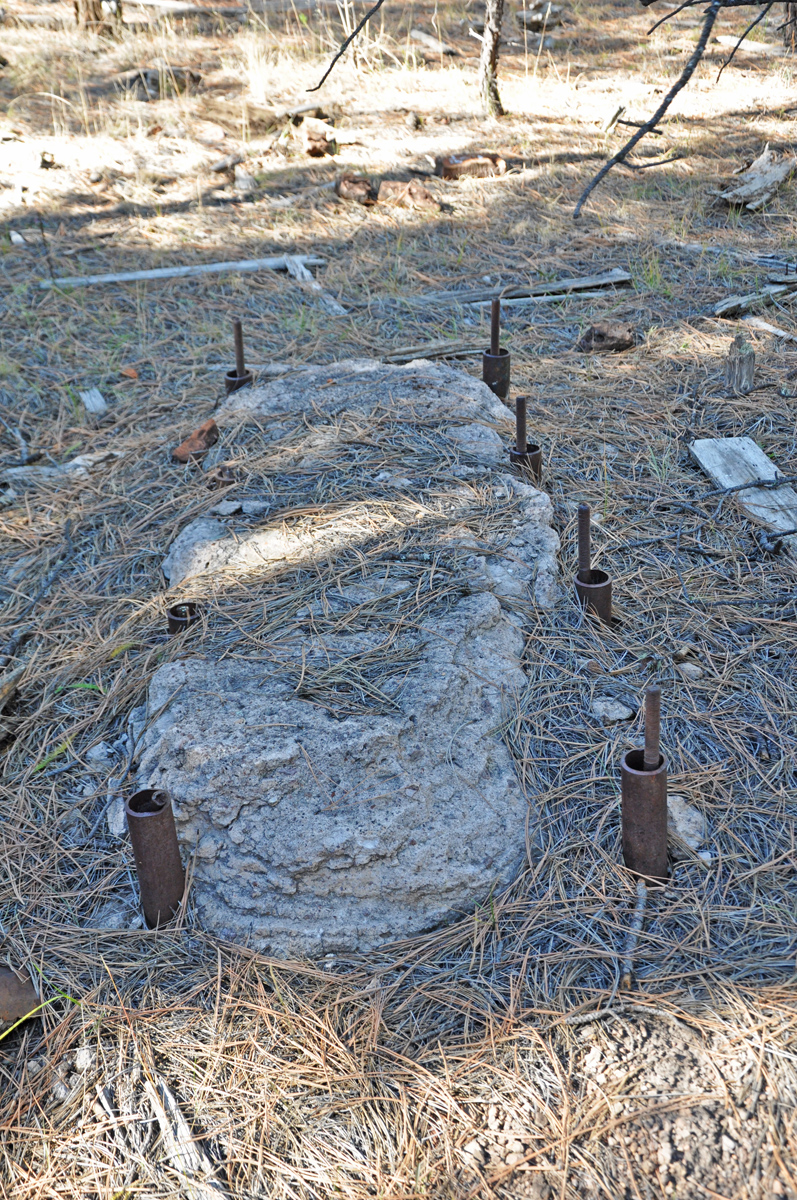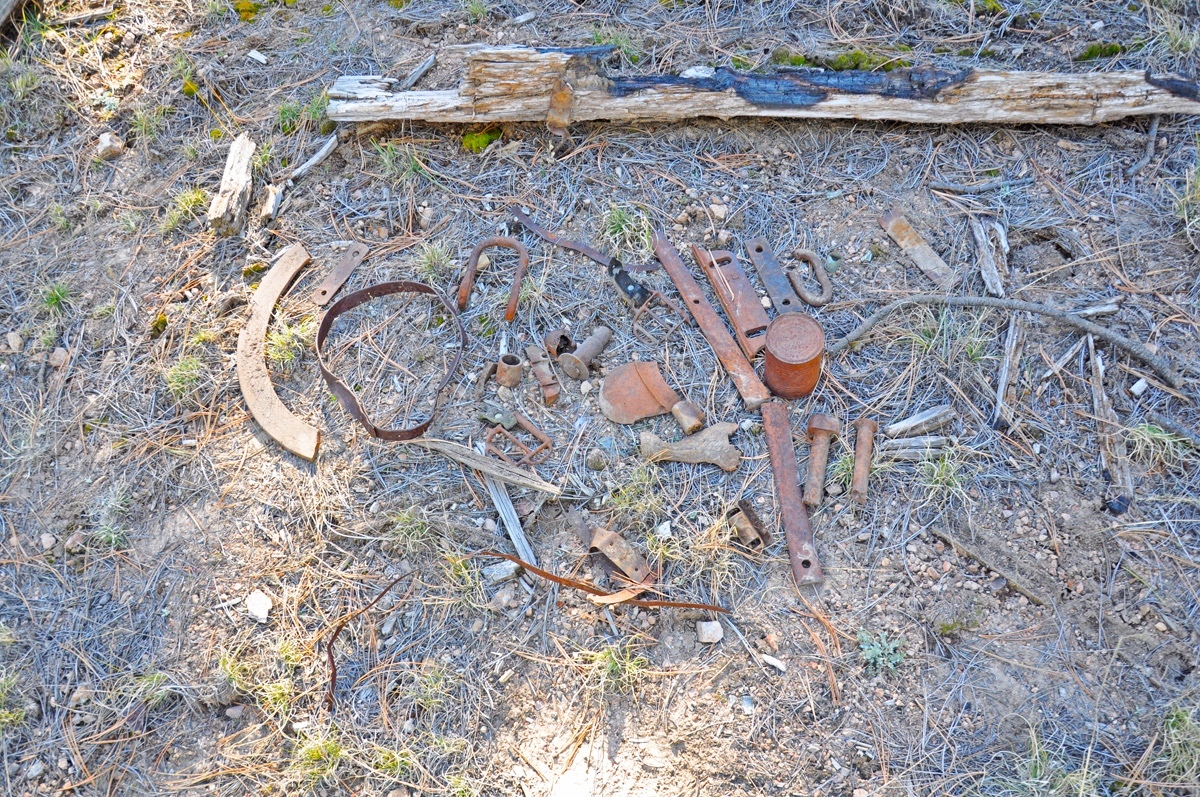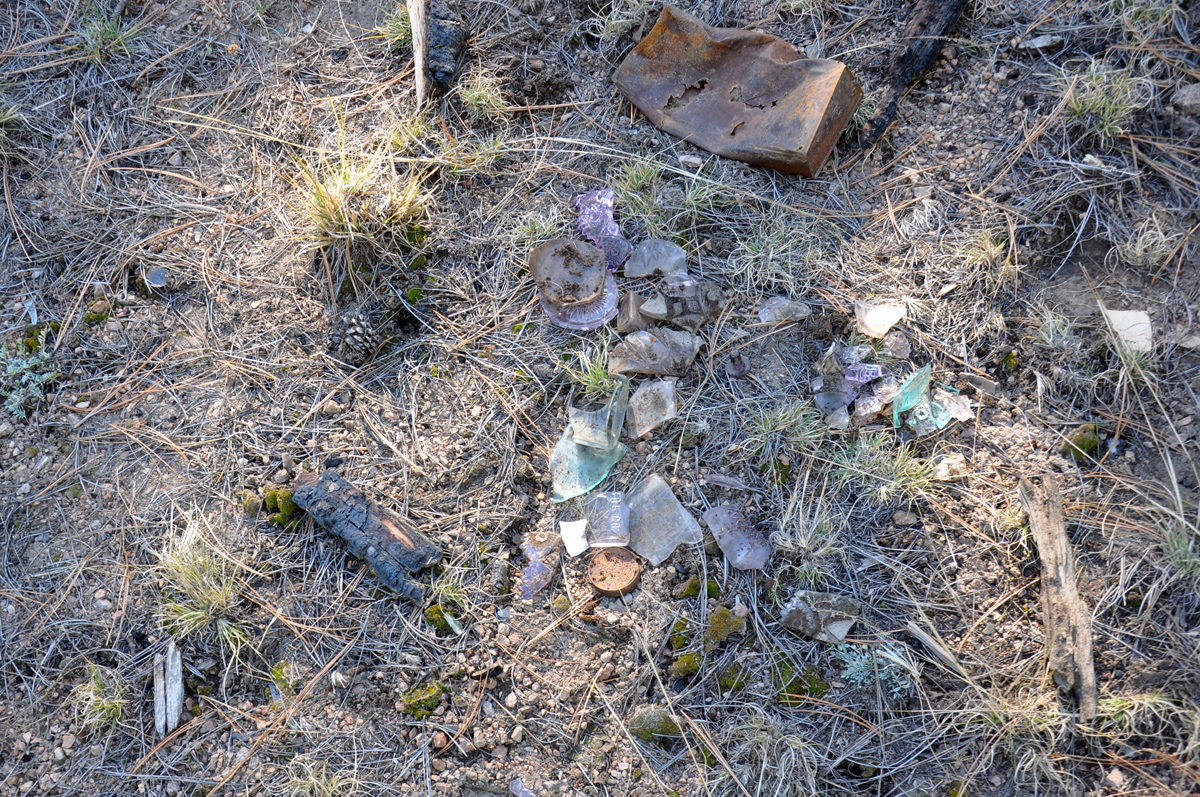Bartlett Sawmill
Supplier of Much Needed Lumber
Note: The above picture from the J.E. Smith Collection is of a steam powered sawmill in the San Mateo Mountains. Although highly likely, at this time, we cannot definitively say it is the Bartlett sawmill. It is steam powered and of the time when J.E. Smith was taking photos in the area. (Click images for a larger view.)
One thing a growing town needs, especially a town supporting a mining community, is timber and cut lumber. In the early days charcoal was used for early smelting, logs and timbers were used for shoring in the mines, and, of course, boards were needed for homes, stores, and mining facilities. Frank G. Bartlett and his partner Mr. John M. Tyler recognized this need in Magdalena and Kelly.
Mr. Frank G. Bartlett came to New Mexico in 1879. Early on, he saw the potential that Magdalena had to offer a businessman. In the New Mexico Territory census of 1885, they were both shown to live in Magdalena (Precinct 12). Mr. Tyler was married at the time. Click here to take you to the Frank G. Bartlett page and learn more detail about this pioneer businessman.
Bartlett Sawmill
Sometime between 1879 and 1884, Bartlett and Tyler established a sawmill at Point of Rocks Canyon. Mr. Bartlett expounded upon the sawmill’s potential during an interview for the Prospectus of the New Town of Magdalena, N.M., published by the New Mexico Town Company, Santa Fe, N.M., 1884-5:
“The following is had with Mr. Bartlett, of the firm of Bartlett & Tyler, extensive dealers and shippers of lumber, who have made Magdalena their headquarters. “I will venture to say that there are comparatively few people in this Territory who have any idea of the vast tract of valuable pine timber, which is located within a few miles of Magdalena, our steam mill being only twenty-five miles distant. The tract covers about a million acres, and yields about 30,000 feet to the acre, and each tree will average one thousand feet. As to quality, it compares favorably with Michigan lumber, and when the Railroad reaches here, we shall push out right lively for trade, not only in this Territory, but in Old Mexico, and North-Western Texas as well.””
Magdalena Business
Frank Bartlett erected the first building in Magdalena and conducted the first mercantile store, probably as an outlet for his lumber. However, advertisements in the newspapers (like this 1888 advertisement in the Black Range newspaper in Chloride) stated that they also sold pumps, pipes, windmill, saddles, wagons, and other hardware.
The following excerpt comes from the 1906 Mines and Minerals Journal:
“Wood and Fuel.–Timber of fair size and quality for the mine stulls [A timber used for the support of overhead rock or the hanging wall.] and sets comes from the pine forests covering the rolling country just west of Magdalena; from the same source is prepared the lumber that is sold for construction by the local saw mill. The local piñon and cedar is used for house fuel, but for steam plants the soft coal from Gallup, N. Mex., is secured for $4.15 a ton.”
It Begins with a Map
At Concho Hills Guest Ranch, we are always researching to find areas of historical significance to show our guests. We spend a lot of time looking for homesteads, wells, springs, and ranches. While reviewing the 1884 original survey for Township 5S, Range 7W, we found reference to Bartlett’s Sawmill. As it is only 8 or so miles from our ranch, we decided we should go see what if anything remains of the site. We were not disappointed.
Remnants and Artifacts of the Sawmill
This is the cement and iron foundation for the sawmill’s steam engine. It is located in relation to the decaying wooden foundations of the buildings as shown in the Smith photograph. The problem with steam engines of the 1800s is that much of the steam exhausted to the atmosphere and they had a lot of leaks. Therefore, they used a lot of water. The Smith Collection of photographs, show a water wagon used by the sawmill to bring water from a distant well or spring. It was pulled by 10 oxen.
Iron Artifacts
We found numerous iron artifacts. From the broken leg of a wood stove to barrel bands and condensed milk cans, there was plenty to wonder about. Broken harness buckles as a result of too much strain on the flawed metal can cause one to imagine the pull of the mule against the harness. I wish we had better records to make a more complete picture of the mill. Who worked here? How many? Were they full time workers or rather part time ranchers trying to make ends meet or work for extra cash?
Glass Fragments
Judging from the bottle fragments we can say one thing in conclusion, the loggers and sawmill operators had a lot of aches and pains! There were a lot of “remedy” bottles. Of course, we also found some whisky bottle fragments. Seems like breaking the bottles was a favorite pastime of the workers, or perhaps the site has been gone over by bottle pickers. There were pieces of some pretty fancy cut glass serving dishes. Were there women here in addition to the men?
Remember, any of the J.E. Smith collection that are seen on this site can be purchased at the Alamo Gallery and Gifts in Socorro, N.M.
References:
- The Albuquerque Morning Journal., September 29, 1882,
- Colorado, New Mexico, Utah, Nevada, Wyoming and Arizona Gazetteer and Business Directory, 1884-5, Vol. I, Published by R. L. Polk & Co. and A. C. Danser
- Prospectus of the New Town of Magdalena N.M. Located at the terminus of the Magdalena Branch of the A.T. & S.F. Railroad, New Mexico Town Company, Santa Fe, N.M. 1884-5
- Mines and Minerals a mining and metallurgical Journal, Vol. XXVII—No. 2, Scranton, PA. September 1906
- The Black Range, Chloride, NM Sept.14, 1888

